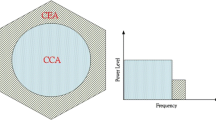Abstract
Recent research has shown that coordinated multi point (CoMP) transmission can provide significant gains in terms of the overall cell capacity and cell-edge user throughput [1]. The main purpose of this paper is to enhance the overall cell throughput, the cell-edge user’s throughput, and the fairness among user equipment terminals (UEs) in LTE-Advanced (LTE-A) systems using CoMP. Towards that end, we propose two novel resource allocation (RA) strategies based on the Signal-to-Leakage-plus-Noise-Ratio (SLNR) for the downlink of CoMP transmission in LTE-A systems. The proposed RA strategies select the UEs that can efficiently share the same resource block (RB) without degrading the overall throughput by using the SLNR metric. Moreover, a fairness algorithm is proposed to achieve certain level of fairness among the UEs and to improve the cell-edge UEs throughput. In addition, we compare the proposed strategies to the RA based on the more common Signal-to-Interference-plus-Noise-Ratio (SINR) strategy. The SLNR-based RA is shown to provide significant gains in throughput reaching up to 80 % in the overall system and is shown to have even less complexity than the typical SINR-based RA. Moreover, by evaluating the proposed strategies in terms of the average cell throughput, cell-edge user throughput, and fairness among UEs, simulations show that the proposed strategies present superior performance compared to the more common SINR strategy. With such advantages as enhanced throughput and lower complexity, the proposed schemes are suitable for application in practical cellular systems.















Similar content being viewed by others
References
Gesbert, D., Hanly, S., Huang, H., Shamai, S., Simone, O., & Yu, W. (2010). Multi-cell MIMO cooperative networks: A new look at interference. IEEE Journal on Selected Areas in Communications, 28(9), 1380–1408.
3GPP R1–050833, (2005). Interference mitigation in evolved UTRA/UTRAN, LGE Electronics.
Yu, W., Kwon, T., & Shin, C. (2010). Joint scheduling and dynamic power spectrum optimization for wireless multicell networks. In CISS (pp. 1–6).
Parkvall, S. et al., (2008). LTE-advanced-evolving LTE towards IMT-advanced. In VTC- fall vehicular technology conference, IEEE 68th (pp. 1–5).
Wang, Q., Jiang, D., Liu, G., & Yan, Z. (2009). Coordinated multiple points transmission for LTE-advanced systems. In 5th International conference wireless communications, networking and mobile computing, WiCom (pp. 1–4).
Hosein, P. (2010). Coordinated radio resource management for the LTE downlink: The two-sector case. In IEEE international communications (ICC) conference (pp. 1–5).
Venturino, L., Prasad, N., & Wang, X. (2009). Coordinated scheduling and power allocation in downlink multicell OFDMA networks. IEEE Transactions on Vehicular Technology, 58(6), 2835–2848.
Sawahashi, M., Kishiyama, Y., Morimoto, A., Nishikawa, D., & Tanno, M. (2010). Coordinated multipoint transmission/reception techniques for LTE-advanced. IEEE Wireless Communications, 17(3), 26–34.
Kiani, S., & Gesbert, D. (2008). Optimal and distributed scheduling for multicell capacity maximization. IEEE Transactions on Wireless Communications, 7(1), 288–297.
Bian, H., Guo, C., & Feng, C. (2010). An ICSGC algorithm for carrier assignment in downlink coordinated multi-point with carrier aggregation. In 2nd IEEE international network infrastructure and digital content conference (pp. 934–938).
Gesbert, D., Kiani, S., Gjendemsj, A., & Oien, G. (2007). Adaptation, coordination, and distributed resource allocation in interference-limited wireless networks. Proceedings of the IEEE, 95(5), 2393–2409.
Dahrouj, H., & Yu, W. (2010). Coordinated beamforming for the multicell multi-antenna wireless system. IEEE Transactions on Wireless Communications, 9(5), 1748–1759.
Zhang, H., Xu, X., Li, J., & Tao, X. (2010). Subcarrier resource optimization for cooperated multipoint transmission. International Journal of Distributed Sensor Networks, 2010, 1–7.
Brueck, S., Zhao, L., Giese, J., & Amin, M. A. (2010). Centralized scheduling for joint transmission coordinated multi-point in LTE-advanced. In International smart antennas (WSA) ITG, Workshop (pp. 177–184).
Jungnickel, V. et al. (2009). Coordinated multipoint trials in the downlink. In IEEE GLOBECOM Workshops (pp. 1–7).
Batista, R. L., dos Santos, R. B., Maciel, T. F., Freitas, W. C., & Cavalcanti, F. R. (2010). Performance evaluation for resource allocation algorithms in CoMP systems. In IEEE 72nd vehicular technology conference (pp. 1–5).
Devarajan, R., Jha, S. C., Phuyal, U., & Bhargava, V. K. (2012). Energy-aware resource allocation for cooperative cellular network using multi-objective optimization approach. IEEE Transactions on Wireless Communications, 11(5), 1797–1807.
Chen, R., Bendlin, R., Onggosanusi, E., & Ekpenyong, A. (2012). Single and multi-cell scheduling in coordinated multi-point distributed antenna systems. In Globecom—wireless communications symposium (pp. 4653–4657).
Sadek, M., Tarighat, A., & Sayed, A. H. (2007). A leakage-based precoding scheme for downlink multi-user MIMO channels. IEEE Transactions on Wireless Communications 6, 1711–1721.
Tarighat, A., Sadek, M., & Sayed, A. H. (2005). A multi user beamforming scheme for downlink MIMO channels based on maximizing signal-to-leakage ratios. IEEE International Conference on Acoustics, Speech and Signal Processing, 3, 1129–1132.
Ist-Winner, II, D1.1.2, WINNER II Channel Models (2007). http://www.ist-winner.org/deliverables.html. Accessed 11 Nov 2011.
Luo, Z.-Q., & Zhang, S. (2008). Dynamic spectrum management: Complexity and duality. IEEE Journal on Selected Topics in Signal Processing, 2(1), 57–73.
Al-Rawi, M., Jantti, R., Torsner, J., & Saqfors, M., (2010). Channel-aware inter-cell interference coordination for the uplink of 3G LTE networks. In Wireless telecommunications, symposium (pp. 1–5).
Jain, R., Chiu, D. M., Hawe, W. (1984). A quantitative measure of fairness and discrimination for resource allocation in shared systems. Eastern Research Lab, DEC Research, Report TR-301 (pp. 1–37).
Abdelaal, R. A., Elsayed, K., & Ismail, M. H. (2012). Cooperative scheduling, precoding, and optimized power allocation for LTE-advanced CoMP systems. In IEEE wireless says (pp. 1–6).
Author information
Authors and Affiliations
Corresponding author
Additional information
This work is part of the 4G++ research project supported by the National Telecom Regulatory Authority (NTRA) of Egypt.
Rights and permissions
About this article
Cite this article
Abdelaal, R.A., Elsayed, K.M.F. & Ismail, M.H. Joint Scheduling and Resource Allocation with Fairness Based on the Signal-to-Leakage-plus-Noise Ratio in the Downlink of CoMP Systems. Wireless Pers Commun 75, 1891–1913 (2014). https://doi.org/10.1007/s11277-013-1444-x
Published:
Issue Date:
DOI: https://doi.org/10.1007/s11277-013-1444-x




